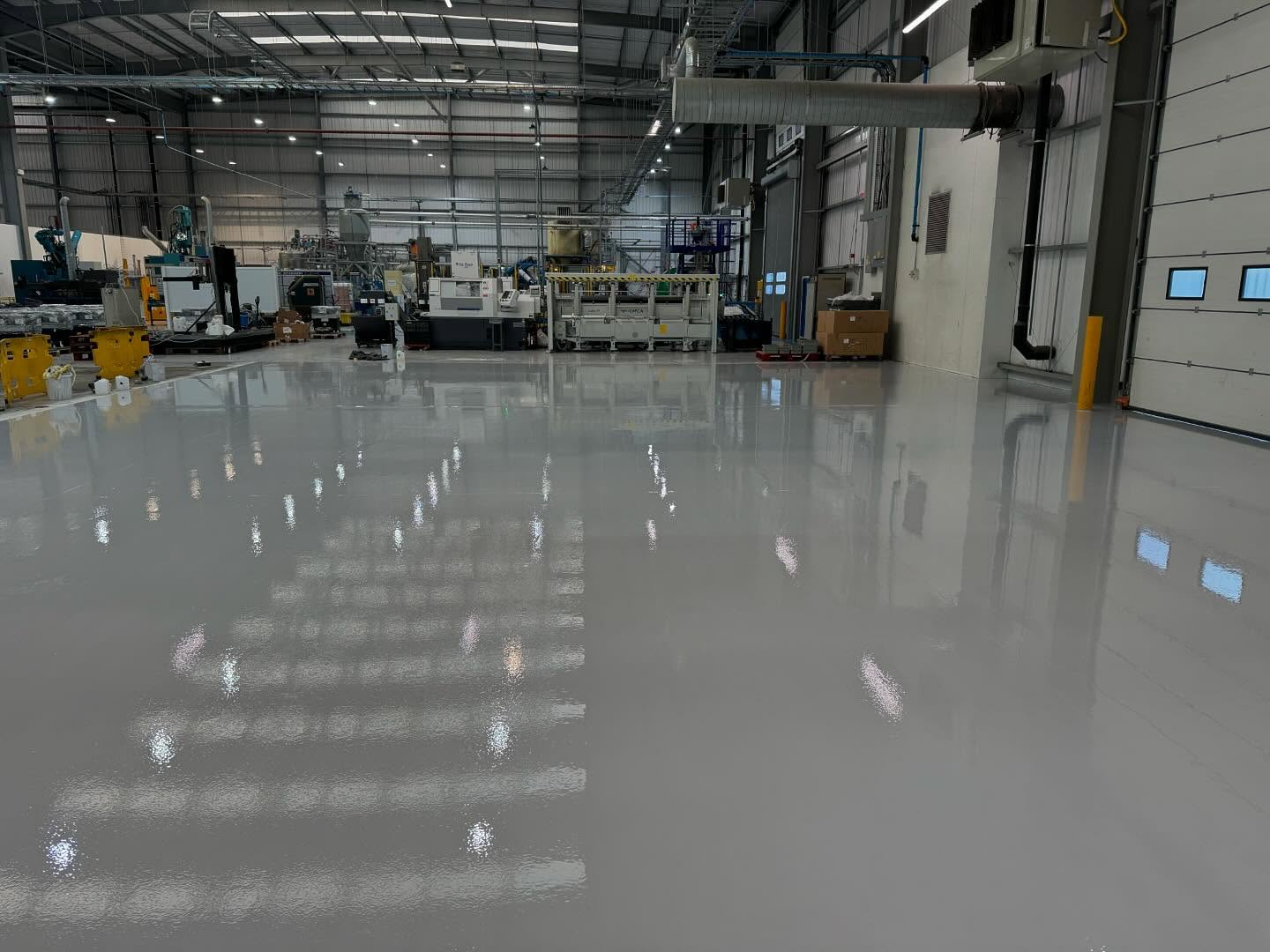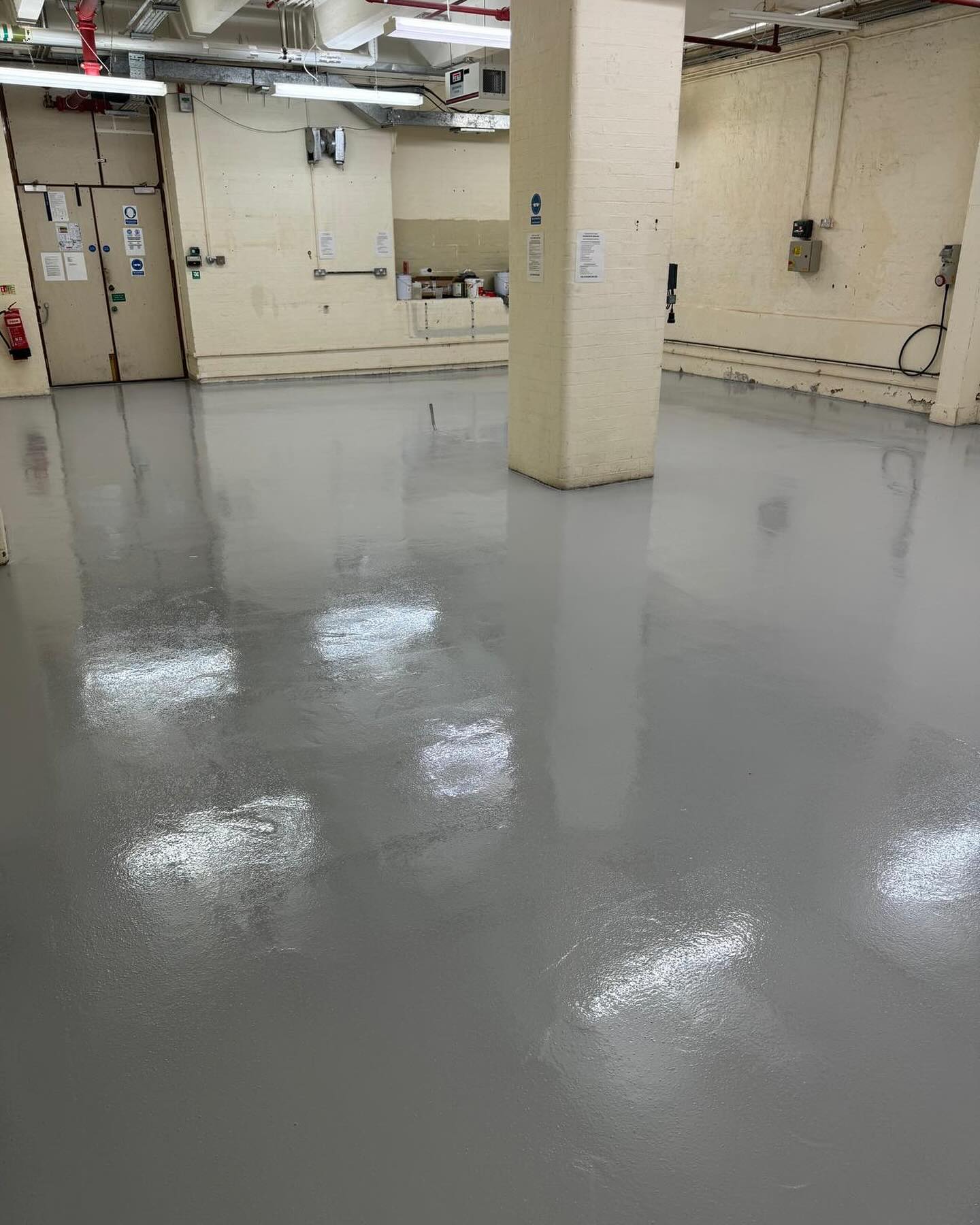ESD epoxy flooring provides permanent static control with 10⁶-10⁹ ohms resistance, seamless installation, and 15-20 year lifespan at £11-15 per m². Anti-static vinyl offers 10⁸-10¹¹ ohms resistance with easier installation at £11-15 per m² but requires seam welding and only lasts 8-12 years, making ESD epoxy superior for critical electronics manufacturing.
Static electricity destroys millions of pounds worth of electronic components annually. The choice between ESD epoxy systems and anti-static vinyl flooring determines whether your facility meets BS EN 61340-5-1 standards consistently or faces ongoing compliance challenges. Having tested both systems in cleanrooms and electronics facilities across London, we'll explain the critical differences that affect both safety and certification.
Understanding Resistance Standards and Measurements
ESD (Electrostatic Dissipative) floors maintain resistance between 10⁶ and 10⁹ ohms, rapidly draining static charges without creating safety hazards. This "Goldilocks zone" prevents both static build-up and electrical shock risks. Conductive carbon fibres dispersed throughout the epoxy thickness ensure consistent performance regardless of wear.
Anti-static vinyl typically provides 10⁸ to 10¹¹ ohms resistance, sufficient for basic static control but approaching the insulative threshold at the upper range. Performance depends on surface treatments and environmental humidity, creating variability that complicates compliance documentation.
| Property | ESD Epoxy | Anti-Static Vinyl |
|---|---|---|
| Resistance Range | 10⁶ - 10⁹ ohms | 10⁸ - 10¹¹ ohms |
| BS EN 61340-5-1 | Full compliance | Marginal compliance |
| Body Voltage | <100V guaranteed | <2000V typical |
| Charge Decay | <0.1 seconds | 0.5-2 seconds |
| Walking Test | <35V peak | <100V peak |
Consistent Performance Through System Life
ESD epoxy maintains electrical properties throughout its 15-20 year lifespan. The conductive network exists through the entire 2-3mm thickness, so surface wear doesn't affect performance. Annual testing consistently shows readings within 5% of initial values, simplifying compliance documentation.
Anti-static vinyl relies on surface treatments and conductive backing that degrade over time. Foot traffic wears away surface coatings, while cleaning chemicals can strip anti-static properties. We've seen vinyl floors fail ESD testing within 3 years despite proper maintenance, requiring expensive retreatment or replacement.

Critical Installation Requirements
ESD epoxy installation demands precision:
- Copper grounding tape grid at 3-metre centres
- Conductive primer ensuring substrate connection
- Carbon-loaded epoxy applied seamlessly
- Connection to building earth at multiple points
- Resistance testing at 1-metre grid points
- 72-hour cure before energising equipment
Anti-static vinyl installation appears simpler but hides complexity:
- Conductive adhesive application (moisture-sensitive)
- Precise tile alignment to maintain conductivity
- Welded seams preventing static accumulation
- Copper strips under seams for continuity
- Edge grounding every 20 square metres
- 24-hour acclimation before testing
Need ESD Flooring for Electronics Manufacturing?
Our certified installers ensure your static control flooring meets BS EN 61340-5-1 standards. Free resistance testing included.
Get ESD Compliance QuoteMaintenance Protocols and Testing Requirements
ESD epoxy requires minimal specialised maintenance. Standard cleaning with neutral pH detergents maintains both appearance and electrical properties. Avoid wax-based products that insulate the surface. Quarterly resistance testing takes minutes per test point, with results typically unchanged year-over-year.
Anti-static vinyl demands careful maintenance to preserve properties. Only approved anti-static cleaners prevent performance degradation. Monthly application of conductive maintenance coatings may be necessary in high-traffic areas. Testing frequency increases to monthly in critical areas due to performance variability.
Total Cost Including Hidden Factors
| Cost Element | ESD Epoxy | Anti-Static Vinyl |
|---|---|---|
| Material per m² | £11-15 per m²-£11-15 per m² | £15-£11-15 per m² |
| Installation per m² | £10-£15 | £10-£15 |
| Grounding System | £3-£5 | £5-£8 |
| Total Initial Cost | £11-15 per m²-£11-15 per m² | £11-15 per m²-£11-15 per m² |
| Annual Maintenance | £0.50-£1 | £2-£4 |
| Retreatment (5 years) | Not required | £8-£12 |
| 15-Year Total | £11-15 per m²-£11-15 per m² | £11-15 per m²-£11-15 per m² |

Service Life in Demanding Environments
ESD epoxy withstands electronics manufacturing conditions for 15-20 years. The seamless surface prevents contamination critical in cleanroom environments. Chemical resistance to isopropyl alcohol, flux removers, and cleaning solvents remains unaffected by the conductive additives.
Anti-static vinyl typically requires replacement after 8-12 years in manufacturing environments. Seams lift under thermal cycling from reflow ovens and wave soldering equipment. THF and other aggressive solvents used in electronics assembly can dissolve vinyl and compromise seam welds.
Industry-Specific Performance Requirements
For semiconductor manufacturing: ESD epoxy provides the <10⁷ ohms resistance essential for wafer fabrication. Seamless installation prevents particle generation that destroys yields.
For data centres: Either system works for general areas, but ESD epoxy better suits critical equipment zones where consistent low resistance matters.
For electronics assembly: Anti-static vinyl suffices for basic PCB assembly where 10⁹ ohms resistance meets requirements and easier spot replacement benefits high-traffic areas in manufacturing flooring installations.
For pharmaceutical cleanrooms: ESD epoxy's seamless, non-porous surface meets GMP requirements while providing static control for sensitive equipment.
Making the Right Static Control Choice
Choose ESD epoxy when:
- Manufacturing sensitive components (<100V HBM)
- Cleanroom standards require seamless floors
- Consistent long-term performance critical
- Chemical exposure from electronics manufacturing
- 15+ year service life expected
Select anti-static vinyl for:
- General electronics storage areas
- Office spaces requiring basic static control
- Temporary facilities or leased spaces
- Areas requiring frequent reconfiguration
- Budget-constrained projects accepting higher maintenance
Consider combination approaches: ESD epoxy in critical manufacturing zones with anti-static vinyl in support areas optimises both performance and budget.
For standard industrial needs without static control, explore our general epoxy versus vinyl comparison. For heavy-duty options, see our guide on chemical-resistant flooring systems.
Ensure Your ESD Compliance
Don't risk electronic component damage. Our ESD flooring experts design and install systems that maintain compliance throughout their service life.
Schedule Your ESD Assessment